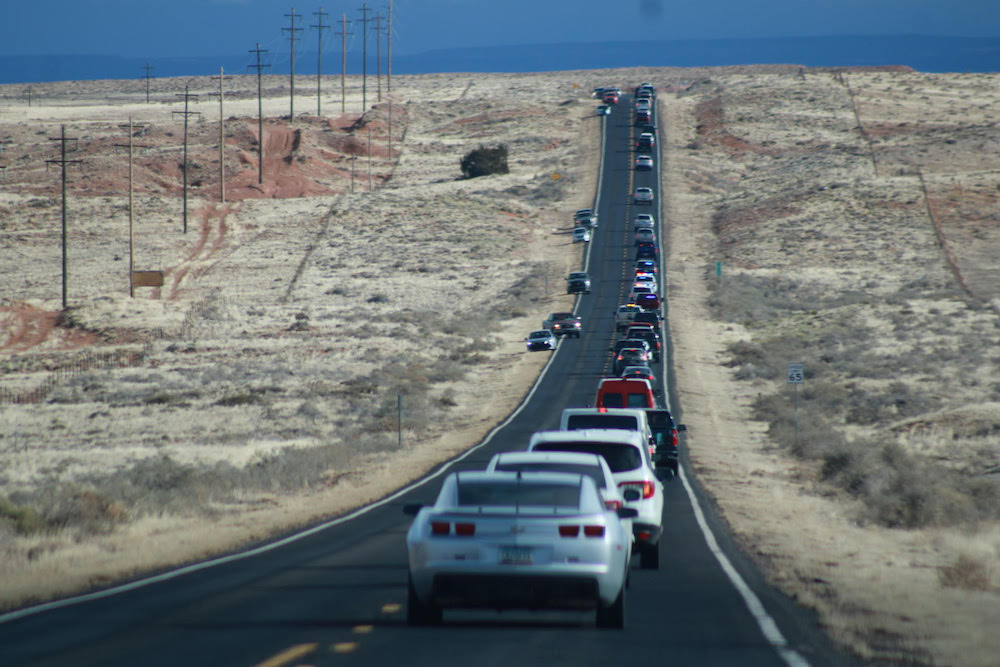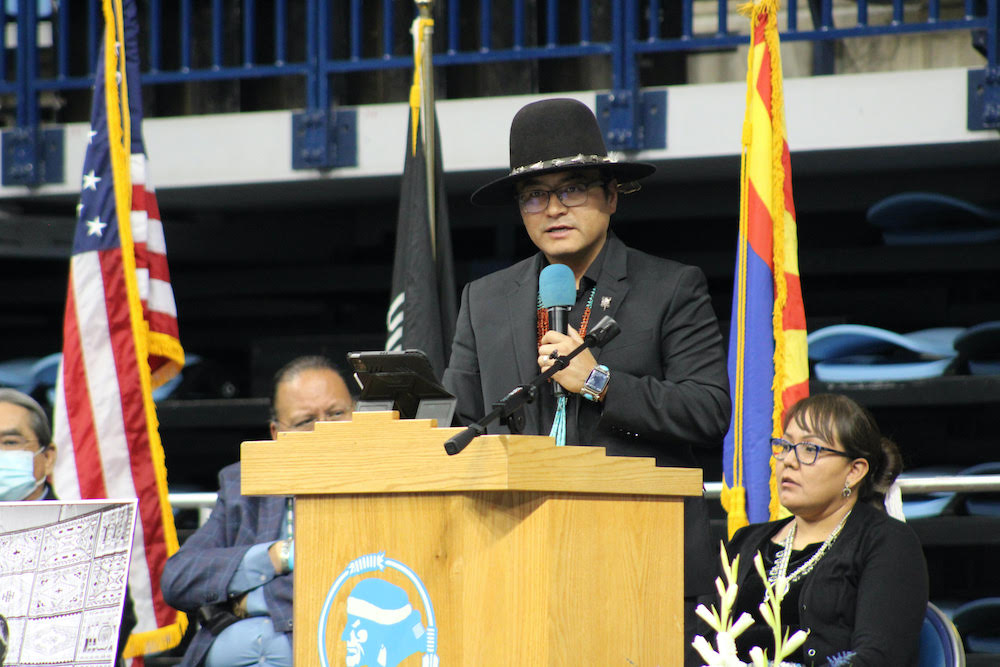
- Details
- By Darren Thompson
WINDOW ROCK, Ariz.—Peterson Zah, the first president of the Navajo Nation, was remembered Saturday with a memorial service and 100-mile funeral procession that stretched from western New Mexico to eastern Arizona.
Zah, who walked on last Tuesday at the age of 85, was a legendary leader many described as an inspiration and one of the greatest American Indian leaders in history. He served as chairman of the Navajo Nation Council from 1983 to 1987, and later won the Nation’s first presidency in 1990, after the Tribe changed its government to three branches: executive, judiciary, legislative.
On Saturday, Zah’s funeral procession was led by the Navajo Nation Police Department and began at 8:00 a.m. in Tse Bonito, N.M., drove through Window Rock, the capital of the Navajo Nation, and ended in Low Mountain, Ariz. The Navajo Tribal Utility Authority hoisted 150-foot American flags from their utility trucks along the route. Many families stood with Navajo Nation flags waving to the family and friends of Zah and live-streaming the procession for their families.
"He was a great man, he was always out there with the people," said Jimarison Bizahaloni, Navajo Nation citizen, who brought his son to watch the motorcade along the route in Cottonwood, Ariz. Bizahaloni was recently honorably discharged by the U.S. Army while stationed in Texas.
Zah was buried on his family's lot in Low Mountain, Ariz., where he was also born in 1937. After the burial, a memorial service and reception were hosted at the Bee Holdzil Fighting Scouts Events Center in nearby Fort Defiance. Many leaders, dignitaries, and community members came to pay their respects in a memorial service that lasted more than three-and-a-half hours.
Speakers for Peterson Zah's Memorial included Navajo Nation President Dr. Buy Van Nygren and Navajo Nation Speaker Crystalyne Curley, as well as Gila River Indian Community Governor Stephen Roe Lewis, former Hopi Tribal Chairman Ivan Sidney, journalist Mark Trahant, and other dignitaries and friends.
 Navajo Nation President Dr. Buu Van Nygren welcomes visitors to the memorial for former Navajo Nation President Peterson Zah at the Bee Holdzil Fighting Scouts Events Center in Fort Defiance, Arizona on Saturday , March 11, 2023. (Photo: Darren Thompson) "I've known Pete Zah for more than 40 years," Dr. Manley Begay Jr., one of Zah's memorial speakers, told Native News Online. "We were absolutely close and we called one another brothers. Today, for me, is a celebration of his life. It's a beautiful day, it's raining outside. He brought the rain."
Navajo Nation President Dr. Buu Van Nygren welcomes visitors to the memorial for former Navajo Nation President Peterson Zah at the Bee Holdzil Fighting Scouts Events Center in Fort Defiance, Arizona on Saturday , March 11, 2023. (Photo: Darren Thompson) "I've known Pete Zah for more than 40 years," Dr. Manley Begay Jr., one of Zah's memorial speakers, told Native News Online. "We were absolutely close and we called one another brothers. Today, for me, is a celebration of his life. It's a beautiful day, it's raining outside. He brought the rain."
Zah was described by many as a loving father, husband, and respected and trusted leader of the Navajo people.
Robert Joe, the master of ceremonies for Zah’s memorial, remembered his friend's effect on people throughout Navajo Nation and Indian Country.
“His footprints and fingerprints are monumental. He led with compassion and a crystal clear vision of what is right for the people first. He always put the people before him, to do what is right."
While chairman, Zah established the Navajo Nation Permanent Trust Fund in 1985 with some of the proceeds of a $217 million award the Tribe won in a taxation lawsuit against Kerr McGee. The case was heard by the Supreme Court of the United States and established that Navajo Nation had authority to tax extraction companies operating on the reservation. He renegotiated oil, gas and coal leases as well as pipeline and electric transmission right-of-way to increase revenues for the Tribe. The Permanent Fund now has billions of dollars.
Navajo Nation President Dr. Bu Van Nygren welcomed visitors and spoke of Zah's mentorship and influence on his life, which began while he was a student at Arizona State University.
"I learned what leadership really meant, to be there, to witness the passion Zah had for education," Nygren said. "He always said education is how we're going to get ahead."
Nygren also read a letter from President Joe Biden and Vice President Kamala Harris that was sent to Zah’s family.
"History will forever remember President Peterson Zah as the first president of the Navajo Nation and a great leader who cared deeply about the future and prosperity of his people," they wrote. "We join the Navajo people in mourning his loss and offer our heartfelt condolences to your family."
After his term as president, Zah became the first special advisor to the president of Arizona State University (ASU) on American Indian Initiatives in 1995, where he worked until 2011.
While Zah was at ASU, the American Indian student population doubled from 672 to more than 1,400 and he is credited to the increase of retention rates of American Indian students from 43 percent to 78 percent.
Lewis, governor of the Gila River Indian Community, said Zah's loss is the passing of an era.
"I'm here to represent my family and my community, to show respect and to honor a great and charismatic leader," Lewis said. "All of Indian Country mourns for you today in the loss of a husband and a patriarch of a family. We mourn the loss of his brilliant mind, his personality, his words of wisdom and a shining example of a humble, courageous and dignified leader."
Mark Trahant, a former Navajo Times editor and currently editor-at-large for ICT, reflected on Zah’s leadership traits and how they mirrored those of other great leaders he’s interviewed over the years.
"I've been lucky enough to interview the Dalai Lama to Mary Robinson, the president of Ireland," Trahant said. "I've spent time with some of Indian Country's most brilliant leaders and there are traits they all share. First, a clear vision. He knew where he was heading and why it was important. Second, he could explain things and make it understandable. The third aspect of leadership I saw was he could get people to do things they didn't know they could do."
Zah played a role in advocating for the traditional use of peyote in ceremonies, too. He was instrumental in advocating for legislation that protects the use of peyote in religious ceremonies in 1967 on the Navajo Nation as well as leading the national effort to amend the American Indian Religious Freedom Act (AIRFA) in the 1990s to include the possession and use of peyote in ceremonies.
David S. Clark, the founder of Azee' Bee Nahagha of Dine Nation (ABND), recalled efforts he and Zah took together to advocate for the use of peyote in traditional ceremonies in 1995.
"It was through President Zah's leadership that peyote legislation was passed in the American Indian Religious Freedom Act Amendment of 1994," Clark said. A few months after the amendment was signed into law, the Navajo Nation hosted a celebration in Window Rock with many U.S. congressional representatives and President Zah thanked them, Clark said.
"Across Indian Country we are mourning alongside the Navajo Nation," Ryan Wilson, former president of the National Indian Education Association and current president of the National Alliance to Save Native Languages, told Native News Online. "Together, with sister Lorraine Zah Babe, the Zah family has made immeasurable contributions to Indian education leaving a prodigious legacy at Navajo Nation and with all of us who love Indian education."
Actor Robert Redford also sent a letter to Peterson Zah's family that was read by Mark Trahant. "It was with a heavy heart to learn of the recent passing of Mr. Zah and we wanted to express our collective condolences and deep sympathy for a tremendous loss," the letter said. "Mr. Zah was an inspiration, a strong and compassionate leader loved by all. His legacy will live on with the many people he touched."
More Stories Like This
Native News Weekly (August 25, 2024): D.C. BriefsUS Presidents in Their Own Words Concerning American Indians
Monday Morning: (January 5, 2026): Articles You May Have Missed This Past Weekend
Native News Weekly (January 4, 2026): D.C. Briefs
What Native American Members of Congress Are Saying about the Venezuela Operation
Help us defend tribal sovereignty.
At Native News Online, our mission is rooted in telling the stories that strengthen sovereignty and uplift Indigenous voices — not just at year’s end, but every single day.
Because of your generosity last year, we were able to keep our reporters on the ground in tribal communities, at national gatherings and in the halls of Congress — covering the issues that matter most to Indian Country: sovereignty, culture, education, health and economic opportunity.
That support sustained us through a tough year in 2025. Now, as we look to the year ahead, we need your help right now to ensure warrior journalism remains strong — reporting that defends tribal sovereignty, amplifies Native truth, and holds power accountable.
 The stakes couldn't be higher. Your support keeps Native voices heard, Native stories told and Native sovereignty defended.
The stakes couldn't be higher. Your support keeps Native voices heard, Native stories told and Native sovereignty defended.
Stand with Warrior Journalism today.
Levi Rickert (Potawatomi), Editor & Publisher
